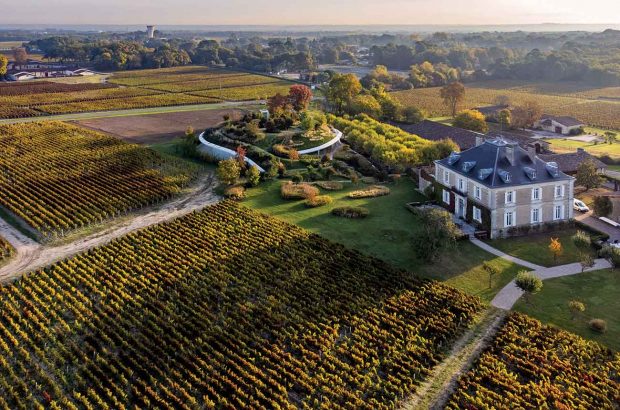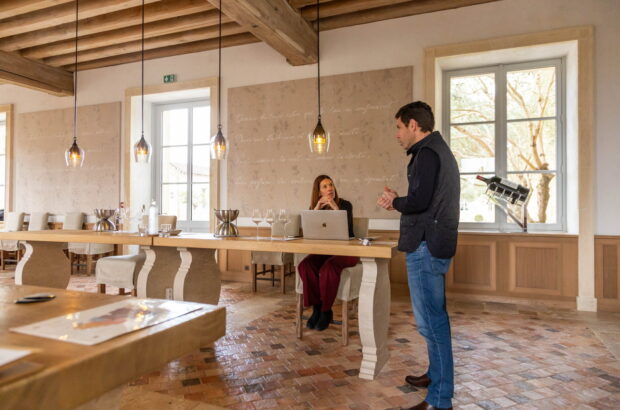Champagne doesn’t have much of a reputation for collective-mindedness. Ever since the region’s governing body decided to force growers to lower their yields during the Covid-hit summer of 2020, fearful of an oversupply of bottles and an undersupply of occasions to drink them, growers and houses have been grappling with a series of disagreements.
First there was confusion and protest from a group of ecologically minded vignerons unhappy with the region’s quiet retreat from a proposed herbicide ban, with 125 winegrowers signing an indignant letter to French newspaper Le Monde in December 2022.
There was grumbling among some growers, too, over proposed changes to rules on vineyard design which some believe benefit large producers eyeing up cheaper, mechanised vineyard work. On paper, there hasn’t been much to agree on. The truth, though, is that Champagne is more collaborative than it seems.
{"content":"PC9wPgo8aDM+PHN0cm9uZz5UaGUgb3JpZ2lucyBvZiBMZSBQcmludGVtcHMgZGVzIENoYW1wYWduZXM8L3N0cm9uZz48L2gzPgo8cD5MZSBQcmludGVtcHMgZGVzIENoYW1wYWduZXMgc3RhcnRlZCBsaWZlIGluIDIwMDkgYXMgYW4gZWZmb3J0IGJ5IG9uZSBncm91cCBvZiBpbmRlcGVuZGVudCBwcm9kdWNlcnMsIFRlcnJlcyBldCBWaW5zIGRlIENoYW1wYWduZSwgdG8gc2hvdyBvZmYgdGhlaXIgbmV3IDxlbT52aW5zIGNsYWlyczwvZW0+IOKAkyB0aGUgc3RpbGwgYmFzZSB3aW5lcyBkZXN0aW5lZCB0byBiZSB0dXJuZWQgaW50byBDaGFtcGFnbmUuIFRoZSBncm91cHMgaGF2ZSBzaW5jZSBtdWx0aXBsaWVkLCB3aXRoIDI2IG9uIHNob3cgdGhpcyB5ZWFyLCByZXByZXNlbnRpbmcgaHVuZHJlZHMgb2YgZXN0YXRlcyBhbmQgdGhvdXNhbmRzIG9mIHdpbmVzLiA8ZW0+VmlucyBjbGFpcnM8L2VtPiBhcmUgc3RpbGwgb24gb2ZmZXIsIGJ1dCBtb3N0IHBlb3BsZSBhdHRlbmQgdG8gdGFzdGUgdGhlIGZpbmlzaGVkIHByb2R1Y3QuPC9wPgo8cD48ZGl2IGNsYXNzPSJhZC1jb250YWluZXIgYWQtY29udGFpbmVyLS1tb2JpbGUiPjxkaXYgaWQ9InBvc3QtaW5saW5lLTIiIGNsYXNzPSJpcGMtYWR2ZXJ0Ij48L2Rpdj48L2Rpdj48L3A+CjxwPk1hbnkgb2YgdGhlIGdyb3VwcyBtYWtlIHVzZSBvZiBhIChzb21ldGltZXMgZmFpcmx5IGxvb3NlKSB0aGVtZS4gR3JhbmRzIENydXMgZOKAmUV4Y2VwdGlvbiwgZm9yIGV4YW1wbGUsIHNob3djYXNlcyBvbmUgcmVwcmVzZW50YXRpdmUgZnJvbSBlYWNoIG9mIENoYW1wYWduZeKAmXMgMTcgZ3JhbmQgY3J1IHZpbGxhZ2VzLiDigJhJdCBzdGFydGVkIHdpdGggYSBmcmllbmRzaGlwIOKAkyBiZXR3ZWVuIErDqXLDtG1lIEdyb3NsYW1iZXJ0IGZyb20gQ2hhbXBhZ25lIEZyYW7Dp29pcyBTZWNvbmTDqSBpbiBTaWxsZXJ5IGFuZCBUYXJlayBCZXJyYWRhIGZyb20gQ2hhbXBhZ25lIEVybmVzdCBSZW15IGluIE1haWxseeKAmSwgSsOpcsO0bWUgTGVncmFzLCBvZiBMZWdyYXMgJmFtcDsgSGFhcyBpbiBDaG91aWxseSwgZXhwbGFpbnMuIEl0IGRpZG7igJl0IHRha2UgbG9uZyB0byBmaWxsIHVwIHRoZSBzcG90cywgYW5kIHRoZSBncm91cCBldmVuIG1hZGUgYSB3aW5lIHRvZ2V0aGVyIGluIDIwMTcsIGJsZW5kaW5nIGFsbCB0aGVpciBmcnVpdC4g4oCYSXQgd2FzIHdpbmVtYWtpbmcgYnkgdm90ZSwg4oCcc2hhbGwgd2UgZG8gdGhpcyBkb3NhZ2Ugb3IgdGhhdCBkb3NhZ2UsIHJhaXNlIHlvdXIgaGFuZHMh4oCd4oCZLCBMZWdyYXMgam9rZXMuPC9wPgo8cD5MZXMgRmHigJlCdWxsZXVzZXMgZGUgQ2hhbXBhZ25lLCBhbm90aGVyIG9mIHRoZSBzbWFsbGVyIGdyb3VwcyBvbiBzaG93LCBpcyBhIGNlbGVicmF0aW9uIG9mIGluZGVwZW5kZW50IGZlbWFsZSB3aW5lbWFrZXJzIGZyb20gYWxsIG92ZXIgdGhlIHJlZ2lvbi4gVGhlIENlcmNsZSBkZXMgQ3JlYXRldXJzIGZvY3VzZXMgb24gb2FrLWFnZWQgd2luZXM7IFBhc3Npb24gQ2hhcmRvbm5heSBvbiB0b3AgcHJvZHVjZXJzIG9mIEJsYW5jIGRlIEJsYW5jcy4gVGhlcmXigJlzIGV2ZW4gYSBncm91cCBvZiBjby1vcGVyYXRpdmVzLCBub3csIGFzIHdlbGwgYXMgZ3JvdXBzIG9mIHNvbWUgb2YgdGhlIG1vc3QgY2VsZWJyYXRlZCBncm93ZXJzIGluIENoYW1wYWduZS48L3A+CjxkaXYgaWQ9ImF0dGFjaG1lbnRfNTAyOTQ4IiBzdHlsZT0id2lkdGg6IDY0MHB4IiBjbGFzcz0id3AtY2FwdGlvbiBhbGlnbmNlbnRlciI+PGltZyBmZXRjaHByaW9yaXR5PSJoaWdoIiBkZWNvZGluZz0iYXN5bmMiIGFyaWEtZGVzY3JpYmVkYnk9ImNhcHRpb24tYXR0YWNobWVudC01MDI5NDgiIGNsYXNzPSJsYXp5bG9hZCBibHVyLXVwIHNpemUtbGFyZ2Ugd3AtaW1hZ2UtNTAyOTQ4IiBkYXRhLXByb2Nlc3NlZCBzcmM9Imh0dHBzOi8vd3d3LmRlY2FudGVyLmNvbS93cC1jb250ZW50L3RoZW1lcy9zaW1iYS10aGVtZS9hc3NldHMvaW1hZ2VzL3BsYWNlaG9sZGVyLnBuZyIgZGF0YS1zcmM9Imh0dHBzOi8va2V5YXNzZXRzLnRpbWVpbmN1ay5uZXQvaW5zcGlyZXdwL2xpdmUvd3AtY29udGVudC91cGxvYWRzL3NpdGVzLzM0LzIwMjMvMDUvTGVzLUZhYnVsbGV1c2VzLTYzMHg0MTcuanBnIiBhbHQ9IkxlIFByaW50ZW1wcyBkZXMgQ2hhbXBhZ25lcyIgd2lkdGg9IjYzMCIgaGVpZ2h0PSI0MTciIGRhdGEtc2l6ZXM9ImF1dG8iIGRhdGEtc3Jjc2V0PSJodHRwczovL2tleWFzc2V0cy50aW1laW5jdWsubmV0L2luc3BpcmV3cC9saXZlL3dwLWNvbnRlbnQvdXBsb2Fkcy9zaXRlcy8zNC8yMDIzLzA1L0xlcy1GYWJ1bGxldXNlcy02MzB4NDE3LmpwZyA2MzB3LCBodHRwczovL2tleWFzc2V0cy50aW1laW5jdWsubmV0L2luc3BpcmV3cC9saXZlL3dwLWNvbnRlbnQvdXBsb2Fkcy9zaXRlcy8zNC8yMDIzLzA1L0xlcy1GYWJ1bGxldXNlcy0zMDB4MTk4LmpwZyAzMDB3LCBodHRwczovL2tleWFzc2V0cy50aW1laW5jdWsubmV0L2luc3BpcmV3cC9saXZlL3dwLWNvbnRlbnQvdXBsb2Fkcy9zaXRlcy8zNC8yMDIzLzA1L0xlcy1GYWJ1bGxldXNlcy0xMzV4ODkuanBnIDEzNXcsIGh0dHBzOi8va2V5YXNzZXRzLnRpbWVpbmN1ay5uZXQvaW5zcGlyZXdwL2xpdmUvd3AtY29udGVudC91cGxvYWRzL3NpdGVzLzM0LzIwMjMvMDUvTGVzLUZhYnVsbGV1c2VzLTMyMHgyMTIuanBnIDMyMHcsIGh0dHBzOi8va2V5YXNzZXRzLnRpbWVpbmN1ay5uZXQvaW5zcGlyZXdwL2xpdmUvd3AtY29udGVudC91cGxvYWRzL3NpdGVzLzM0LzIwMjMvMDUvTGVzLUZhYnVsbGV1c2VzLTYyMHg0MTAuanBnIDYyMHcsIGh0dHBzOi8va2V5YXNzZXRzLnRpbWVpbmN1ay5uZXQvaW5zcGlyZXdwL2xpdmUvd3AtY29udGVudC91cGxvYWRzL3NpdGVzLzM0LzIwMjMvMDUvTGVzLUZhYnVsbGV1c2VzLTkyMHg2MDkuanBnIDkyMHcsIGh0dHBzOi8va2V5YXNzZXRzLnRpbWVpbmN1ay5uZXQvaW5zcGlyZXdwL2xpdmUvd3AtY29udGVudC91cGxvYWRzL3NpdGVzLzM0LzIwMjMvMDUvTGVzLUZhYnVsbGV1c2VzLTEyMjB4ODA3LmpwZyAxMjIwdywgaHR0cHM6Ly9rZXlhc3NldHMudGltZWluY3VrLm5ldC9pbnNwaXJld3AvbGl2ZS93cC1jb250ZW50L3VwbG9hZHMvc2l0ZXMvMzQvMjAyMy8wNS9MZXMtRmFidWxsZXVzZXMuanBnIDEzMDB3IiBzaXplcz0iKG1heC13aWR0aDogNjMwcHgpIDEwMHZ3LCA2MzBweCIgLz48cCBpZD0iY2FwdGlvbi1hdHRhY2htZW50LTUwMjk0OCIgY2xhc3M9IndwLWNhcHRpb24tdGV4dCI+VGhlIGZlbWFsZSB3aW5lbWFrZXJzIHdobyBmb3JtIHRoZSBncm91cCBMZXMgRmEmIzgyMTc7QnVsbGV1c2VzIGRlIENoYW1wYWduZS4gQ3JlZGl0OiBMZXMgRmEmIzgyMTc7YnVsbGV1c2VzIGRlIENoYW1wYWduZS48L3A+PC9kaXY+CjxkaXYgY2xhc3M9ImFkLWNvbnRhaW5lciBhZC1jb250YWluZXItLW1vYmlsZSI+PGRpdiBpZD0icG9zdC1pbmxpbmUtMyIgY2xhc3M9ImlwYy1hZHZlcnQiPjwvZGl2PjwvZGl2Pgo8aDM+PHN0cm9uZz5BbiBvdmVyaGVhdGVkIG1hcmtldDwvc3Ryb25nPjwvaDM+CjxwPlRoZSBtYXJrZXQgZm9yIGluZGVwZW5kZW50IENoYW1wYWduZSBpcyB2ZXJ5IGRpZmZlcmVudCB0b2RheSBjb21wYXJlZCB0byAyMDA5LiBJbiBzaG9ydCwgdGhlIHdpbmVzIGFyZSBwcmFjdGljYWxseSBzZWxsaW5nIHRoZW1zZWx2ZXM6IOKAmEl04oCZcyB2ZXJ5IGRpZmZpY3VsdOKAmSwgZXhwbGFpbnMgRmHigJlCdWxsZXVzZXMgbWVtYmVyIEjDqWzDqG5lIEJlYXVncmFuZCwgd2hvIHdhcyBwb3VyaW5nIGhlciB3aW5lcyBkZXNwaXRlIGZldyBhdHRlbmRlZXMgaGF2aW5nIGFueSByZWFsIHByb3NwZWN0IG9mIGJ1eWluZyB0aGVtLiDigJhJ4oCZdmUgcnVuIG91dCBvZiBldmVyeXRoaW5nIHVuZGVyIG15IG93biBsYWJlbOKAmS48L3A+CjxwPldpdGggbWFueSBvZiB0aGUgdG9wLCBlc3RhYmxpc2hlZCBpbmRlcGVuZGVudCBkb21haW5lcyBpbmNyZWFzaW5nbHkgdGllZC11cCwgdGhlIGh1bnQgZm9yIG5ldyBuYW1lcyBpcyBhbG1vc3QgZnJhbnRpYy4gSXTigJlzIGVhc3kgdG8gc2VsbCwgYW5kIHNvIG1hbnkgd2luZXMgb24gb2ZmZXIgYXJlIHZlcnkgeW91bmcuIE9uZSBQcmludGVtcHMgdmV0ZXJhbiB0aG91Z2h0IHRoZSBxdWFsaXR5IG9mIHdoYXQgd2FzIG9uIG9mZmVyIGZyb20gbmV3IGZhY2VzIGF0IHRoZSBtb21lbnQgaXMgbm90IGFzIGhpZ2ggYXMgaXQgc2hvdWxkIGJlOiDigJhTb21lIG9mIHRoZSBpbXBvcnRlcnMgSSBrbm93IGhhdmUgYmVlbiB2ZXJ5IGRpc2FwcG9pbnRlZOKAmSwgc2hlIHNheXMsIGV4cHJlc3Npbmcgd2lkZWx5IGhlbGQgZnJ1c3RyYXRpb24gYXQgdGhlIG92ZXJoZWF0ZWQgbWFya2V0LjwvcD4KPGRpdiBjbGFzcz0iYWQtY29udGFpbmVyIGFkLWNvbnRhaW5lci0tbW9iaWxlIj48ZGl2IGlkPSJwb3N0LWlubGluZS00IiBjbGFzcz0iaXBjLWFkdmVydCI+PC9kaXY+PC9kaXY+CjxwPkZhbnMgb2Ygc3VwZXItY2xlYW4sIHByaXN0aW5lIGFuZCBsb25nZXItYWdlZCBDaGFtcGFnbmVzIGZyb20gd2VsbC1rbm93biBob3VzZXMgbWlnaHQgZmluZCBsZXNzIHRvIGVuam95IGluIHRoZSBjdXJyZW50IGNyb3Agb2YgbmV3IHByb2R1Y2VycyB0aGFuIHRob3NlIHdobyBlbmpveSBhIG1vcmUgbmF0dXJhbGx5IHN0eWxlZCwgeW91dGhmdWwgYW5kIGJvbmUtZHJ5IGFwcHJvYWNoLjwvcD4KPGgzPjxzdHJvbmc+V2hhdCYjODIxNztzIHRoZSBidXp6Pzwvc3Ryb25nPjwvaDM+CjxwPlRoZSBtYXJjaCB0b3dhcmRzIGRyb3BwaW5nIGJvdGggc3VscGhpdGUgbGV2ZWxzIGFuZCBkb3NhZ2UgbGV2ZWxzIGNvbnRpbnVlcywgd2l0aCBtYW55IHdpbmVzIHNob3dpbmcgYm90aCBhIG1vcmUgb3BlbiwgZWFybHkgZGV2ZWxvcGVkIHByb2ZpbGUgYW5kIGludmlnb3JhdGluZyBkcnluZXNzLiBPYWsgdXNhZ2UsIHRvbywgaXMgc28gcHJldmFsZW50IHRoYXQgaXQgaXMgbm93IGEgYml0IG9mIGEgbm92ZWx0eSB0byBzZWUgaW5kZXBlbmRlbnQgQ2hhbXBhZ25lIG1hZGUgd2l0aG91dCBpdC48L3A+CjxkaXYgY2xhc3M9ImFkLWNvbnRhaW5lciBhZC1jb250YWluZXItLW1vYmlsZSI+PGRpdiBpZD0icG9zdC1pbmxpbmUtNSIgY2xhc3M9ImlwYy1hZHZlcnQiPjwvZGl2PjwvZGl2Pgo8cD5QZXJoYXBzIHRoZSBtb3N0IG5vdGFibGUgcmVhc29uIGZvciBwb3NpdGl2aXR5IGlzIG92ZXJhbGwgYXR0aXR1ZGVzIHRvd2FyZHMgd2hhdOKAmXMgaGFwcGVuaW5nIGluIHRoZSB2aW5leWFyZHM7IHRoZSBCdWxsZXMgQmlvIHRhc3Rpbmcgd2FzIGEgZ2lnYW50aWMsIHNwcmF3bGluZywgYnV6emluZyBmZXN0aXZhbCBvZiBhbG1vc3QgNTAgcHJvZHVjZXJzIG9mIDxzdHJvbmc+PGEgaHJlZj0iaHR0cHM6Ly93d3cuZGVjYW50ZXIuY29tL2xlYXJuL29yZ2FuaWMtYW5kLW5hdHVyYWwtd2luZS1kaWZmZXJlbmNlLTQzMzExNi8iIHRhcmdldD0iX2JsYW5rIiByZWw9Im5vb3BlbmVyIG5vcmVmZXJyZXIiPm9yZ2FuaWM8L2E+IDwvc3Ryb25nPmFuZCA8c3Ryb25nPjxhIGhyZWY9Imh0dHBzOi8vd3d3LmRlY2FudGVyLmNvbS9sZWFybi93aW5lLXRlcm1pbm9sb2d5L2Jpb2R5bmFtaWMtdnMtb3JnYW5pYy1hc2stZGVjYW50ZXItMjk2MDA4LyIgdGFyZ2V0PSJfYmxhbmsiIHJlbD0ibm9vcGVuZXIgbm9yZWZlcnJlciI+YmlvZHluYW1pYzwvYT4gPC9zdHJvbmc+Q2hhbXBhZ25lLCBhIGNhdGVnb3J5IHRoYXQgbm93IHJlcHJlc2VudHMgYWxtb3N0IDklIG9mIHRoZSByZWdpb24mIzgyMTc7cyB2aW5leWFyZCBhcmVhLjwvcD4KPHA+Tm90IGFsbCB0aGUgZ3JvdXBzIGJvYXN0ZWQgc3VjaCBhIHN0cm9uZyBtYW5pZmVzdG8gKG5vciB0aGUgZ2VuZXJhbGx5IGhpZ2ggc3RhbmRhcmQgc2VlbiBmcm9tIGdyb3VwcyBzdWNoIGFzIFRlcnJlcyBldCBWaW5zLCBMZXMgTWFpbnMgZHUgVGVycm9pciBhbmQgUGFzc2lvbiBDaGFyZG9ubmF5KSwgYW5kIGl0IGhhcyB0byBiZSBzYWlkIHRoYXQgbWVyZWx5IGJlaW5nIGEgc21hbGwsIGZhbWlseSBkb21haW5lIGRvZXMgbm90IGF1dG9tYXRpY2FsbHkgaW1wbHkgZXRoaWNhbCBjcmVkZW50aWFscy4gSXQgd2FzIHJhcmUgdG8gZmluZCBhIHJvb20sIHRob3VnaCwgd2l0aG91dCBhdCBsZWFzdCBvbmUgb3IgdHdvIG5hbWVzIHRvIHdhdGNoLjwvcD4KPGhyPgo8ZGl2IGNsYXNzPSJicmVha291dCBwYWxldHRlLWEgcGFuZWwgcGFuZWwtZGVmYXVsdCI+PGRpdiBjbGFzcz0icGFuZWwtYm9keSI+PGRpdiBjbGFzcz0nYnJlYWtvdXQtY29udGVudCc+PC9wPgo8aDIgc3R5bGU9InRleHQtYWxpZ246IGNlbnRlciI+Rml2ZSBjdXJyZW50IHRyZW5kcyBpbiBpbmRlcGVuZGVudCBDaGFtcGFnbmUgYW5kIHRoZSBrZXkgcHJvZHVjZXJzIHRvIHdhdGNoOjwvaDI+CjxwPjxzdHJvbmc+VGhlIDIwMTkgdmludGFnZTwvc3Ryb25nPjwvcD4KPHA+SXQgd2FzIGhvdCBhbmQgZHJ5LCBidXQgc29tZWhvdyB0aGlzIHRvcCB2aW50YWdlIGJvYXN0cyBmcmVzaG5lc3MgYW5kIGRlbGljYWN5IHRvby4gT25lIHRvIHN0b2NrIHVwIG9uLjwvcD4KPHA+PHN0cm9uZz5NYXN0ZXJzIG9mIG9hazwvc3Ryb25nPjwvcD4KPHA+SXTigJlzIG5vdCBqdXN0IHRoZSBmYW1vdXMgbmFtZXMgaW4gZ3Jvd2VyIENoYW1wYWduZSDigJMgVWx5c3NlIENvbGxpbiwgRXJpYyBSb2RleiwgU3VlbmVuIGFuZCB0aGUgbGlrZSDigJMgcGl0Y2hpbmcgdGhlaXIgb2FrIHVzYWdlIHByZXR0eSBwZXJmZWN0bHkgdGhlc2UgZGF5cy4gTG9vayBvdXQgZm9yIHdpbmVzIGZyb20gQmVub8OudCBEw6lodSBhbmQgQ2hhbXBhZ25lIEFsZXhpcyBpbiB0aGUgTWFybmUgVmFsbGV5LiBMYWNvdXJ0ZS1Hb2RiaWxsb24sIExvdWlzIEJyb2NoZXQsIEh1Z3VlcyBHb2Rtw6kgaW4gYW5kIGFyb3VuZCB0aGUgTW9udGFnbmUgZGUgUmVpbXMsIE91ZGlldHRlIGFuZCBDbMOpbWVudCAmYW1wOyBGaWxzIGluIHRoZSBQZXRpdCBNb3JpbiwgQW5kcsOpIEphY3F1YXJ0IGluIFZlcnR1cyBhbmQgbWFueSBtb3JlLjwvcD4KPHA+PHN0cm9uZz5Sb3PDqSDigJMgYmlnIGlzIGJhY2s8L3N0cm9uZz48L3A+CjxwPk1ha2luZyByb3PDqSBieSBtYWNlcmF0aW9uIOKAkyBibGVlZGluZyBjb2xvdXIgZnJvbSB0aGUgc2tpbnMgb2YgdGhlIGdyYXBlcyByYXRoZXIgdGhhbiBibGVuZGluZyB3aXRoIHJlZCB3aW5lIOKAkyBpcyB3ZWxsIGFuZCB0cnVseSBpbiBmYXNoaW9uIG9uY2UgYWdhaW4uIFRoZSByZXN1bHRzIGNhbiBiZSBkZWVwLCBmcnVpdHksIHZpbm91cyBhbmQgZm9vZC1mcmllbmRseTsgYSBmYXIgY3J5IGZyb20gYW55IGltYWdlIG9mIHJvc8OpIENoYW1wYWduZSBhcyBhIHN3ZWV0LW5hdHVyZWQgc3Vuc2hpbmUgYXBlcml0aWYuIEZhdm91cml0ZXMgZnJvbSB0aGUgd2VlayB3ZXJlIGZyb20gRW1pbGUgR3JhZG9zIGluIExlcyBSaWNleXMsIEJlbm\/DrnQgRMOpaHUgaW4gRm9zc295LCDDiWxpc2UgRGVjaGFubmVzIGFuZCBMb3Vpc2UgQnJpc29uIGluIHRoZSBDw7R0ZSBkZXMgQmFyLCBQaWVycmUgRGV2aWxsZSBpbiBWZXJ6eSBhbmQgRXJuZXN0IFJlbXkgaW4gTWFpbGx5LCBub3QgdG8gbWVudGlvbiBiZXR0ZXIta25vd24gZXhhbXBsZXMgZnJvbSB0b3AgZ3Jvd2VyIGVzdGF0ZXMgc3VjaCBhcyBMYXJtYW5kaWVyLUJlcm5pZXIsIEdlb2Zmcm95IGFuZCBFbW1hbnVlbCBCcm9jaGV0LjwvcD4KPHA+PHN0cm9uZz5QcmVjaXNpb24gaW4gdGhlIEPDtHRlIGRlcyBCYXI8L3N0cm9uZz48L3A+CjxwPkNoYW1wYWduZeKAmXMgc291dGhlcm4gcmVhY2hlcyBoYXZlIGEgcmVwdXRhdGlvbiBmb3IgYnJvYWQsIGZydWl0eSBQaW5vdCBOb2lyLCBidXQgYW4gaW5jcmVhc2luZyBudW1iZXIgb2YgdmlnbmVyb25zIGFyZSBjaG9vc2luZyB0byBjb2F4IG91dCBpbXByZXNzaXZlIGZvY3VzLCB3b3JraW5nIHdpdGggY29vbGVyIHNpdGVzIGFuZCBsaXR0bGUgKG9yIHN1YnRsZSkgb2FrIHVzYWdlLiBMb29rIG91dCBmb3IgUmVteSBNYXNzaW4sIEVsaXNlIETDqWNoYW5uZXMsIExhIEJvcmRlcmllLCBOYXRoYWxpZSBGYWxtZXQgYW5kIFNhbGltYSAmYW1wOyBBbGFpbiBDb3JkZXVpbC48L3A+CjxkaXYgY2xhc3M9ImluamVjdGlvbiI+PC9kaXY+CjxwPjxzdHJvbmc+Q2hhcmRvbm5heSBicmFuY2hlcyBvdXQ8L3N0cm9uZz48L3A+CjxwPkNoYXJkb25uYXkgaGFzIGl0cyBzdHJvbmdob2xkIGluIHRoZSBDw7R0ZSBkZXMgQmxhbmNzLCBidXQgdGhlcmUgYXJlIHBsZW50eSBvZiBzdXBlcmIgQmxhbmMgZGUgQmxhbmNzIGZyb20gZWxzZXdoZXJlIHRvbywgc3VjaCBhcyB0aG9zZSBmcm9tIEhlbnJpIEdvdXRvcmJlIGFuZCBNYXJjIEhlYnJhcnQgaW4gdGhlIEdyYW5kZSBWYWxsw6llIGRlIGxhIE1hcm5lLCBKYWNxdWVzIExhc3NhaWduZSBhbmQgSGVsw6luZSBCZWF1Z3JhbmQgaW4gTW9udGd1ZXV4LCBvciBBIE1hcmdhaW5lIGluIHRoZSBNb250YWduZSBkZSBSZWltcy4gPC9wPgo8L2Rpdj48ZGl2IGNsYXNzPSdicmVha291dC1idXR0b25zJz48ZGl2IGNsYXNzPSdyb3cnPjwvZGl2PjwvZGl2PjwvZGl2PjwvZGl2Pgo8cD4K"}
Related articles












